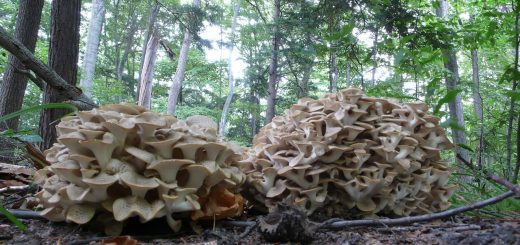#082: Biscogniauxia atropunctata
This fungus is one of a number of ascomycetes that form hard, flat fruiting surfaces on dead or dying hardwood trees. Most fungi with this fruiting habit are black, making the tree appear as though it were burned in discrete spots. However, at a certain stage in its fruiting body development, Biscogniauxia atropunctata is light gray or white and covered in small, black dots.
B. atropunctata is a weak parasite that causes a disease known as Biscogniauxia Canker or Biscogniauxia Dieback (formerly called – and still often referred to as – Hypoxylon Canker or Dieback, after the fungus’s old genus name). Other fungi in the genus Biscogniauxia also cause Biscogniauxia canker, but B. atropunctata is the most common cause of the disease in the United States. B. atropunctata can infect a variety of hardwood trees, but is most common on oaks, particularly red oaks. Most susceptible trees are already infected with the disease, which is easily contained by the trees’ natural defenses. B. atropunctata becomes problematic only when the tree experiences some other type of stress. Damage by pests, other infections, weather, and human activity can all reduce a tree’s ability to fend off the fungus. B. atropunctata is particularly well adapted to surviving in hot, dry weather, so harsh droughts often trigger outbreaks of the disease. The fungus grows the best at 95°F, but will still grow at temperatures up to 104°F. It takes a while for the fungus to actually kill the tree, so tree death often occurs a year or two after a drought.
A tree is initially infected through a wound of some sort. Wounds are common and not necessarily harmful to a tree, so B. atropunctata will live in the wood for some time before it starts damaging the tree. When the tree becomes stressed and can no longer defend itself, B. atropunctata starts actively decomposing the tree’s sapwood (which transports water, sugars, and nutrients). Early symptoms of the disease are indistinguishable from water stress and include: formation of smaller than normal leaves, yellowing leaves, wilting leaves, and dead branches. The fungus grows down the branches to the trunk of the tree. There, it forms a girdling canker which entirely cuts off the tree’s water supply. Although the process of girdling takes weeks or even months, trees with this stage of infection often turn brown and die almost overnight.
Following the death of a branch or tree, B. atropunctata begins to produce fruiting structures. First, a mat of fungal tissue (stroma) forms underneath the bark. As this tissue grows, it exerts more and more pressure on the bark until the bark falls off, revealing the stroma. The stroma is initially white to brown and covered with powdery, asexual spores. These spores are spread to new hosts by the wind or by splashing raindrops. After the asexual spores have been dispersed, the stroma becomes white to gray with small, black dots that are ever so slightly raised above the otherwise flat stroma. These dots are actually the ends of sexual structures known as perithecia. Perithecia (singular: perithecium) are roundish cavities that are lined with asci (the cells which produce sexual spores in the Ascomycota). The center of each dot features a minute pore connecting the interior of the perithecium to the external environment and allowing the spores to be released. As the stroma ages, it turns black. At this point, microscopic analysis will be needed to accurately identify the fungus (make sure you identify the diseased tree, as many Biscogniauxia species only grow on certain types of trees). The stroma is very hard and can remain on the tree for a very long time, allowing the fungus many opportunities to release sexual spores and infect new trees.
B. atropunctata (phylum Ascomycota, class Sordariomycetes, order Xylariales, family Xylariaceae) is a common disease in the southeastern United States and can be found as far north as Pennsylvania and as far west as Oklahoma. The species can also be found in Europe. Biscogniauxia Canker is of particular concern in developed areas, where dead trees are unsightly and potentially hazardous to people below. The best way to prevent the disease is by properly caring for trees. Providing for the trees’ water and nutritional needs and preventing injury to trees during construction and pest management will keep the trees healthy and allow them to keep B. atropunctata in check. Dead branches and trees with signs of the fungus should be quickly removed and burned to prevent the spread of the fungus.
See Further:
http://www.clemson.edu/extension/hgic/tyk/2011/tyk01.html
http://pods.dasnr.okstate.edu/docushare/dsweb/Get/Document-2312/EPP-7620web.pdf
http://mycology.sinica.edu.tw/Xylariaceae/generalInfo.asp?qrySectionName=Biscogniauxia&qryPageID=5
http://www.fungaldiversity.org/fdp/sfdp/25-13.pdf
http://msucares.com/pubs/infosheets/is1798.pdf








![#011: Characteristics of Kingdom Fungi [Archived]](https://www.fungusfactfriday.com/wp-content/themes/hueman/assets/front/img/thumb-small-empty.png)
